Sarah Chorn's Blog, page 58
September 10, 2015
Updraft – Fran Wilde
 About the Book
About the Book
In a city of living bone rising high above the clouds, where danger hides in the wind and the ground is lost to legend, a young woman must expose a dangerous secret to save everyone she loves
Welcome to a world of wind and bone, songs and silence, betrayal and courage.
Kirit Densira cannot wait to pass her wingtest and begin flying as a trader by her mother’s side, being in service to her beloved home tower and exploring the skies beyond. When Kirit inadvertently breaks Tower Law, the city’s secretive governing body, the Singers, demand that she become one of them instead. In an attempt to save her family from greater censure, Kirit must give up her dreams to throw herself into the dangerous training at the Spire, the tallest, most forbidding tower, deep at the heart of the City.
As she grows in knowledge and power, she starts to uncover the depths of Spire secrets. Kirit begins to doubt her world and its unassailable Laws, setting in motion a chain of events that will lead to a haunting choice, and may well change the city forever—if it isn’t destroyed outright.
352 pages
Published on September 1, 2015
Published by Tor
Author’s webpage
Buy the book
This book was sent to me by the publisher in exchange for an honest review.
—
Have you ever ran across a book that you didn’t think you’d want to read but you ended up reading it and being glad you did so? Updraft was that sort of book for me. I didn’t think I’d like it. I had almost no intention of reading it, but once I did, I was damn glad I gave it my time. Updraft surprised me. While in some ways I was a bit torn, the overall experience was lovely. This is a rather ingenious novel, and absolutely memorable because of that.
The first thing that most people will remark on with Updraft is the world building. This is one of the most unique worlds that you will run across, with an obvious social structure, and a society living in bone towers and dependent upon flight for trade and survival. There are also some unique creatures that threaten this society, creatures that have evolved to impact a society that lives high in towers and fly for trade and whatever else.
Fran Wilde has thought of just about everything regarding her world, from social structure, to issues that a society like this would face, to religious organizations, trade agreements and just about anything else you can think of. In fact, the world building is the strongest point of the novel, and it is just about as absorbing as the story itself. It’s hard not to be utterly enchanted by a world that is this different.
The plot is where I’m torn. This novel is adult, but it reads like a young adult crossover in a lot of ways. That’s not a bad thing, but it is something readers should be aware of. For some reason, that caught me off guard. Updraft features a young protagonist who is undergoing some growing pains as she becomes an adult in a world that is requiring a lot from her. Kirit is an easy character to love. She makes some rash decisions and has to cope with the results of those decisions. Things get hairy, and she’s pushed past her comfort zone over and over again. There is a lot of growth that takes place as Kirit moves from young adult to adult.
However, what comes with this is a lot of predictability. I wasn’t ever really that surprised with who the baddies were, or what the end result of the novel would be. Kirit is an easy character to love, and she’s rather wholesome and easy to cheer for, but a lot of the situations she finds herself in aren’t that shocking and it’s pretty easy to see how it will all pan out. That’s not necessarily a bad thing. Sometimes it’s nice to sit back and enjoy a novel that you don’t really have to think that hard about. There is something to be said for a book that you can just sit back and enjoy on just about every level, and sometimes wholesome is refreshing, and predictability is a good thing.
Despite all of that, there is something quite refreshing about being able to enjoy a novel for what it is. Kirit is a wholesome character, and the plot, while predictable, is rather absorbing. It’s really interesting how Wilde managed to merge such an interesting, unique world, with a plot that is, in many ways, classic and time tested. The two elements balance each other well, keeping the book grounded in a human story, while unique enough to be captivating to a wide age range. In the end, this book was a bit predictable, but it worked and I really couldn’t fault it for its predictability.
Updraft was a book that surprised me. The world is absolutely unforgettable, and the story is completely human. Kirit is easy to love, and her plight is one that just about everyone will relate to on some level. This book reads more like a young adult crossover, but that’s not a bad thing. It will appeal to a wide age range. It’s grounded in a very emotional reality, but soars with its fantastic world building. Updraft is worth reading. Fran Wilde is an author to watch.
4/5 stars
September 8, 2015
Tomorrow and Tomorrow – Thomas Sweterlitsch
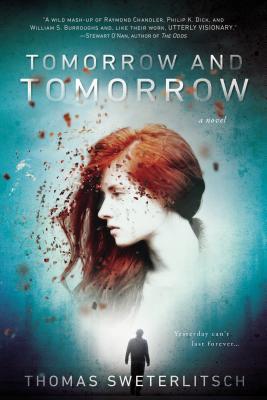 About the Book
About the Book
“A wild mash-up of Raymond Chandler, Philip K. Dick, and William S. Burroughs” (Stewart O’Nan, author of The Odds), the near-future thriller Tomorrow and Tomorrow is an insightful exploration of humanity’s relationship with evolving virtual environments and an accurate portrayal of how the technology that was developed to connect people inevitably isolates them…
Pittsburgh is John Dominic Blaxton’s home even though the city has been uninhabitable ruin and ash for the past decade. The Pittsburgh Dominic lives in is the Archive, an immersive virtual reconstruction of the city’s buildings, parks, and landmarks, as well as the people who once lived there. Including Dominic’s wife and unborn child.
When he’s not reliving every recorded moment with his wife in an endless cycle of desperation and despair, Dominic investigates mysterious deaths preserved in the Archive before Pittsburgh’s destruction. His latest cold case is the apparent murder of a woman whose every appearance is deliberately being deleted from the Archive.
Obsessed with uncovering this woman’s identity and what happened to her, Dominic follows a trail from the virtual world into reality. But finding the truth buried deep within an illusion means risking his sanity and his very existence…
384 pages (paperback)
Published on May 5, 2015
Published by Berkley
Author’s webpage
Buy the book
This book was sent for me to review by the publisher.
—
I really like near future science fiction. It can be terrifying, and almost always thought provoking. The unique vision that authors have of what could happen to our world captivates me. Tomorrow and Tomorrow is a believable, terrifying spin of what the world could be. The strength of it is how plausible it is. It isn’t hard to believe that much of what the author writes about could actually, in some way, become reality in our own world.
Tomorrow and Tomorrow is a dark, rather uncomfortable (in a good way) near future science fiction that centers on a noir feeling mystery. The world, as I mentioned above, is dark and gritty and uncomfortably plausible. The mystery is incredibly well done. It takes time to see how all the threads fit together, and occasionally the book can be a little hard to follow, but it all pans out in surprising ways with plenty of twists and turns to keep readers guessing.
The main character, John Dominic Blaxton, is a broken man who is barely surviving after the tragic death of his wife and child in the bomb that decimated Pittsburgh. After a bad run in with the drug Brown Sugar, Blaxton loses everything and is forced into rehabilitation and therapy. Quickly he finds his investigation services borrowed to help someone find what happened to his daughter, who is being systematically deleted from the archive. His investigation of Albion (the daughter) takes him to surprising places, and he learns some shocking things as the investigation of Albion circles back to the investigation of another unsolved mystery involving a woman named Hannah.
Tomorrow and Tomorrow is a lot of different things – noir, dystopian, mystery and science fiction. It really blends the genres well and is pretty addicting from the start. Blaxton is a fascinating character, because he’s so damaged from the loss of his wife and child. It hangs over him constantly, and his depression and angst is a very real thing. He offers readers an interesting window into this technologically pumped world, a rather gripping vision of just how focused everything is on virtual reality, big brother is always watching, and all that. There are quite a few uncomfortable scenes, as public executions are described, the President of the United States is more of a showgirl than anything else, and there are popular channels where murdered individuals are rated based on their fuckability.
Plenty of messages are subtle, but there are also quite a few which are fairly obvious and could be seen to hit readers over the head. However, the commentary is important, and like I’ve said, it is absolutely gripping in a sort of terrifying way. It’s interesting to see how technology has altered society, and it’s easy to see some of the roots of the situations in the book in our own world here.
The mystery is well done and planned out in such a way that will keep you guessing, though it’s hard for me to say what is more interesting, the plight of our protagonist, or the solving of the mystery itself. The ending isn’t really nicely tied up and packaged for readers, but it’s important to know that not everything in life is nicely boxed and packaged, and some endings are more question marks than periods. That being said, it is hard for me to picture a different sort of ending for a novel like this. It isn’t neat and clean, but neither is the book, and in that respect it stayed true to the feel of the novel as a whole.
Tomorrow and Tomorrow surprised me. It is completely unique, with a style of writing that makes everything feel immediate and incredibly important. It is powerful, and frightening, and will keep you guessing to the very end. That’s part of the magic of it. It’s a book that can’t really be neatly summed up or defined, but you won’t forget it. I am anxious to read more by this author.
4/5 stars
September 7, 2015
Crucible Zero – Devon Monk
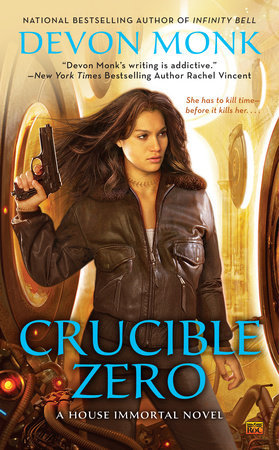 About the Book
About the Book
The national bestselling author of Infinity Bell returns to her “fresh and unique”* world where the truce between the ruling Houses has shattered and chaos now reigns. Only one woman has the power to save the world—but she could also destroy it…
Matilda Case never thought of herself as a hero. But because she is galvanized—and nearly immortal in her stitched, endlessly healing body—she doesn’t have much of a choice. Even if she doesn’t want to save the world, she’s the only one capable of traveling in time to do so.
But her rescue attempt hasn’t gone as planned. She’s stuck in an alternate universe, and her world is in danger of disappearing. Worst of all, an unfathomably powerful man who can also travel through history doesn’t want her to put things to rights. He’s willing to wage bloody war to stop Matilda, unless she surrenders control of time to him.
Now, with the minutes ticking, Matilda must make impossible decisions, knowing that one wrong choice will destroy her—and any chance of saving everything she loves…
356 pages (paperback)
Published on September 1, 2015
Published by Roc
Author’s webpage
Buy the book
This book was sent for me to review by the publisher.
—
I read my first Devon Monk book last year, and I just about instantly fell in love with her work. She writes urban fantasy the way I want it to be written. Her characters are real. The magic systems she creates are vibrant and believable. Her world and plots are unique and compelling. In short, she has a gift for taking a genre that is often stale and unenlightening, and breathing fresh life into it.
Crucible Zero is the last book in her House Immortal trilogy. You should absolutely read the other two books in the series before you read this one. While that might seem like an investment of your time, you won’t regret it. The world is incredibly unique, and the characters are hard not to feel passionately for.
The previous book ended on a bit of a cliffhanger, which annoyed me because I had to wait before I could find out how things turned out in book three. Crucible Zero has a very different feel to it than the previous books, partly because the world that Matilda finds herself in is quite different than the world that we got to know in the previous two books.
Monk was pretty ambitious when telling this story. Matilda lost just about everything that Monk spent so much time building up in two books. While some things remain the same in the third book, the world is very different, and so are the characters that are reintroduced. Monk basically had one book to rebuild a different world, create characters that were different but similar to previous books, and tie up all the loose ends that needed tying up.
I admit, I was very skeptical that it would actually work out, but somehow Monk managed to do everything that needed to be done, and she did it flawlessly.
Monk made some smart decisions. The world is different, and readers will definitely feel that. However, she kept some threads the same. The main plot still centers on Slater Orange. The characters and the house structure are different, but just different enough for readers to get to know them again, but find similarities to who they were in previous books. This causes the book to feel pretty fresh and new, while keeping all the important tidbits the same. The plot moves forward pretty quickly, and there are plenty of surprising twists that will keep you on your toes.
Matilda Case is a character that I instantly loved at the start of this series, and that love just grew with each book. She’s tenacious, and full of passion and zeal. She’s one of those characters that seems to constantly find herself in the middle of every situation, but not in an unbelievable way. It just seems normal that a character this compelling would be in the center of all of the action. Matilda’s plight is a bit darker, and a bit more raw in this third book. She’s lost so much, and has to adjust in some heart wrenching ways, but she manages it because she’s strong. Crucible Zero is equal parts internal and external struggle, and the balance between these struggles is nothing short of captivating.
The ending of Crucible Zero is quite well done. The plot moves quickly, and due to the fact that the world is different and so are the characters, it’s hard to put the book down. You’ll plow through this one pretty quickly, and while the ending is just about perfect for the series as a whole, I do think Monk could have easily expanded this trilogy and made it longer. The world is that complex, and so are the characters. There is plenty here that the author could still build on. However, the fact that she decided to end this at book three ensures that each book remains just as fresh and powerful as the previous, without anything getting overly drawn out.
But you’ll miss the series when it’s over. It’s hard to say goodbye to characters that I loved this much.
Devon Monk is one of my favorite urban fantasy authors, and this series shows a lot of her strengths with characterization, plot, and world building. Crucible Zero is hard not to love. It’s a powerful end to a memorable trilogy. Crucible Zero is quite an ambitious novel, but Monk pulls it off with poise and grace, and all the skill that I know she is capable of. This series is addicting, and incredibly fun. I’m going to miss it.
If you haven’t read this series yet, you really should and sooner rather than later.
4/5 stars
September 2, 2015
Guest Review by A.E. Marling | The House of Shattered Wings – Aliette de Bodard
 About the Book
About the Book
A superb murder mystery, on an epic scale, set against the fall out – literally – of a war in Heaven.
Paris has survived the Great Houses War – just. Its streets are lined with haunted ruins, Notre-Dame is a burnt-out shell, and the Seine runs black with ashes and rubble. Yet life continues among the wreckage. The citizens continue to live, love, fight and survive in their war-torn city, and The Great Houses still vie for dominion over the once grand capital.
House Silverspires, previously the leader of those power games, lies in disarray. Its magic is ailing; its founder, Morningstar, has been missing for decades; and now something from the shadows stalks its people inside their very own walls.
Within the House, three very different people must come together: a naive but powerful Fallen, a alchemist with a self-destructive addiction, and a resentful young man wielding spells from the Far East. They may be Silverspires’ salvation. They may be the architects of its last, irreversible fall.
402 pages (hardcover)
Published on August 20, 2015
Published by Roc
Author’s webpage
Buy the book
Huge thanks to A.E. Marling for writing this review. Learn more about him and his books on his website.
—
If you’d like to hobnob with fallen angels wearing swallowtail suits in post-apocalyptic Paris, read The House of Shattered Wings by Aliette de Bodard. Sip absinthe beside workers on break from coercing rusted machinery in shell-shocked factories. Avoid the liquid malice of the Seine River; its acid waters resent mankind for the poisons of the war, and black waves will gobble up anyone who leans too far off a bridge. Above all, take care at night. There’s more to fear in the darkness than magic-hungry gangs. Something winged this way comes.
Angels plummet from heaven, dazed, all memory lost. All understanding, gone. They do not know why. They have only their grief, and god never answers the prayers of the fallen. The sky has born them down to Earth, and many die within their first hours. A desperate man will tear them apart and eat them raw. Angels are worth their weight in magic.
Philippe is one such man in need. Once he was enlightened. Now exiled and far from the khi currents of his homeland, he needs more power or his gang will cast him adrift in the city chaos. He has to begin eating a newly fallen angel, Isabelle, one finger at a time. Part of him is relieved when a stronger magic user and angel stops him, though he knows then he’s doomed. A warlord of Paris imprisons him in her stronghold, a bastion of tyranny amidst the soot and roadblocks. Or so Philippe sees House Silverspires.
Only in the Great Houses can angels be safe. Here they relearn how to live. They gain more than dapper duds. Magic bolsters their bird bones. Wards protect them from the dystopia. The circle of protection enwraps not only one building but many. House Silverspires is a collection of haunted mansions. More dust lives here than people. Guardian energy shimmers through unused wine cellars. Magic fills in the broken panes in the glass windows of Notre Dame, holding out the city’s madness. Until now.
Philippe brings with him a foreign power. Eating part of the angel Isabelle has linked him to her, and she’s tied to the house’s pulsing wards. The links create a chain of vulnerability, and when Philippe touches a cursed mirror by accident, he unleashes the house’s bane.
“All that you hold dear will be shattered.”
A hissing hatred stalks through the house. Its venom annuls magic and leaves an angel dead in the cathedral. His skin is covered by cryptic circles. His light is snuffed out by a shadow of vengeance. Through walls, across decades of time, it has come from history to obliterate this place of sanctuary.
It has arrived too late. This malice seeks an angel who has long since left, the Morningstar, the First Fallen. Though he hasn’t been seen for years, he still overshadows Silverspires. By his burning sword they knew him, and his wings of razors. On his back, they could be seen “glinting like blades the instant before they cut into flesh.”
The Morningstar’s ruthless dedication built a house of power. With him gone, Silverspires is crumbling. The Lady Selene has more arrogance than leadership. She can only react, never initiate. Her squeamish mercy pinions her in this brutal world. Not even her white bowtie will be enough. Her house will break.
The House of Shattered Wings gives us more than an intoxicating and skin-crawling setting. It also doesn’t stint on diversity. Philippe was raised a Buddhist, when the world was a better place. Lady Selene loves another woman, a black angel named Emmanuelle. Aliette de Bodard cares about showing varied viewpoints. If you’d like a fantasy with an Aztec setting, read her Obsidian and Blood series.
In this book we’re immersed in the perspectives of multiple lost souls. Isabelle the angel will have to overcome her gangly innocence in this smoking ruin of existence. Her faith in others is “pure and incandescent as a falling star.” Her mentor is Madeleine, an alchemist addicted to angel bones. Their powdered potency has burnt out her lungs, but at least a quick death will let her soon forget a lifetime of betrayals. Madeleine would like to believe she can redeem herself by protecting her new charges in Silverspires, yet she knows “miracles never happen” in a city of fallen angels.
As interesting as the characters and setting are, the story loses momentum in its later half due to changing antagonistic forces. The narrative also requires the independent Philippe to begin caring for others again, and I never felt I crossed all the way with on his arc. I wished for a deeper, non-magical bond between him and Isabelle. They might never’ve exchanged more than a few terse words, if he hadn’t eaten her fingers.
Now if you’ll excuse me, I going to slip on some silk gloves and attend a ball in House Hawthorn. The leader, Asmodeus, is something of an angel hipster, but I shan’t hold it against him. His tastes in wines and ancient spellcraft are impeccable.
4/5 stars
September 1, 2015
Regeneration – Stephanie Saulter
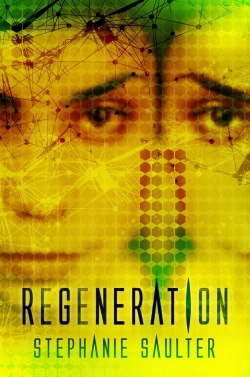 About the Book
About the Book
The gillungs – genetically modified, waterbreathing humans – are thriving. They’ve pioneered new aquatic industries, and their high-efficiency quantum battery technology coupled to tidal turbines in the Thames estuary looks set to revolutionise the energy industry. But as demand grows, so does fear of what their newfound power might mean.
Then a biohazard scare at Sinkat, their London headquarters, fuels the opposition and threatens to derail the gillungs’ progress. Was it an accident born of overconfidence, or was it sabotage?
DS Sharon Varsi has her suspicions, and Gabriel sees parallels in the propaganda war he’s trying to manage: politicians and big business have stakes in this game too. And now there is a new threat: Zavcka Klist is out of prison. With powerful new followers and nothing to lose, she’s out to reclaim everything they took from her.
374 pages (paperback)
Published on August 6, 2015
Published by Jo Fletcher Books
Author’s webpage
Buy the book
This book was sent for me to review by the publisher.
—
Before you read any further, you need to know one thing. I love this series so hard it hurts. It’s pretty impossible for me to read this last book of the trilogy and be anything other than absolutely thrilled by it. I also have a weird penchant for not finishing books that end a series that I absolutely love, because I never want the series to end. If I don’t finish that last book, the series never ends. Or something. (Don’t worry, it doesn’t really make sense to me either.) Finishing this one was incredibly hard for me. The last thing I want is Saulter’s series to end, but I mustered up my herculean strength and actually read every last page despite myself. It was worth it.
Regeneration is the third book in a trilogy that has absolutely broken all the rules, and shined a light on important issues. This series has everything I love, compelling characters, important issues, fantastic writing and a plot to die for. It is important that you read the other two books in the series before you get to this one, but honestly, if you haven’t yet then you need to stop reading this and track down Gemsigns and Binary right away.
Regeneration is a little jump into the future past the other books. It’s interesting to see where some of the characters have ended up, how these complex and developing relationships have panned out, and how the public has adjusted to gems. Each book seems to ask an important question that builds on the previous book, and Regeneration is no different. Status quo has shifted, and the world is shifting to make room for the new normal. Some things have evened out a bit, and other issues have cropped up in their place. In some ways this book is a lot less strained than its predecessors. In other ways, the stress and strain, the worry has just shifted onto a different focus.
Some characters from Gemsigns are back in Regeneration. It’s nice to check back in with them and see how they are doing now. There are also some new characters, but the shift in focus really is on family units and relationships of that nature. Gabriel is back, and he’s older. It’s nice to see how he has aged, how his family life is, and what has become of him. The one thing that I have loved about Saulter’s series is how natural the progression of events is. All of her characters have aged and developed in absolutely believable ways, as has the complex social and political situation. Gabriel is a smart kid, who has an important role in what happens in this book, as does his family. It’s not a stretch to believe their importance and the situations they find themselves in.
Saulter revisits a lot of other characters, too, and as I mentioned above, a lot of this book focuses on family and relationships, from Mikal and Sharon, who are a loving and devoted couple with interesting and important professions, to Eli and Aryel, who are also in a devoted relationship. Other characters that we were introduced to in previous books also make an appearance in this one, and I was gratified to see how many of these characters are in situations, and living lives, that they have been working hard toward in previous novels. It’s all rather heartwarming without being over-the-top or unbelievable. As I’ve said, Saulter has a knack for writing a believable progression of events, and her characters and relationships are also one of her strong suits.
That’s what is so compelling. These aren’t just made up characters. When you read a Saulter book, you’re living another life, and it’s so realistically created that it’s hard not to feel as deeply as these characters, or be rocked by the profound questions that Saulter forces readers to think about.
Regeneration is more than a visit with old friends. The plot focuses on energy, alternative sources of power, mysteries and, of course, Zavcka is back. Saulter did a lot of research while writing this one, and a lot of the scientific ideas she presents readers are easy to understand, and also rather thought provoking in our own age where questions of energy and resources are on a lot of minds. The plot is fast moving, and as you’ve gathered, absolutely absorbing. You shouldn’t expect anything less from a Saulter novel.
Regeneration is the perfect finish to a speculative fiction series that absolutely rocked my world in every respect. This is, hands down, one of the most important science fiction series that has been written recently. I’m so sorry to see this series end, but I’m also delighted that I got to read it. Regeneration is powerful and provocative, and leaves readers on the right note. I really can’t praise this series enough. I’m sad to see it end, but it is absolutely glorious, and a must read for any SpecFic fan.
5/5 stars
August 31, 2015
Guest Post | T. Frohock on Contempt Prior to Investigation
About the Author
Bio: T. Frohock has turned a love of dark fantasy and horror into tales of deliciously creepy fiction. She lives in North Carolina where she has long been accused of telling stories, which is a southern colloquialism for lying.
T. is the author of Miserere: An Autumn Tale and her newest series is Los Nefilim. The first novella, In Midnight’s Silence, is available now. The second novella, Without Light or Guide, will be released in November 2015.
You can catch up to T. at her website or on Twitter.
Contempt Prior to Investigation
by Teresa Frohock
Recently, I saw a tweet in which an individual professed s/he would never read a novel that used the word “mankind” in the blurb. Since the tagline of my Los Nefilim series has the word “mankind” in it (not once, but twice, mind you), the comment sort of drew me up short. I knew the tweeter, and the prejudice made me kind of sad, because I thought the individual might have enjoyed Diago and Miquel’s story.
Personally, I loved the tagline, which was written by my publisher, not by me. I thought it evoked the old radio shows from the 1930s and 1940s, which all utilized taglines to identify specific shows.
I even looked up the word “mankind” to see what all the umbrage was about, but “mankind” is simply defined as: “Human beings collectively, the human race.” That’s from the Oxford dictionary; most other dictionaries concurred with the definition.
I’m not disputing “mankind” is an outdated term. I would definitely use “humankind” if writing a paper or an essay, or even a blog post such as the one I’m writing now; however, In Midnight’s Silence—and the whole Los Nefilim series for that matter—is fiction, which is set in the 1930s. The word, “humankind,” might have been in use in the thirties, but it was hardly common.
 Then there are marketing considerations to take into account. While “humankind” is most certainly proper to modern sensibilities, it’s also a cumbersome word. I mean, let’s face it, from a marketing prospective: The fate of humankind has nothing to do with humankind possesses all visceral pop of wet clay.
Then there are marketing considerations to take into account. While “humankind” is most certainly proper to modern sensibilities, it’s also a cumbersome word. I mean, let’s face it, from a marketing prospective: The fate of humankind has nothing to do with humankind possesses all visceral pop of wet clay.
Marketing attempts to achieve is a feel for the story and the time period in which the story is set. If I think I’m reamed in tight with novella word counts, marketing has it twice as tough in their attempt to capture the atmosphere of a twenty-eight thousand word story with only a sentence.
Of course, my justifications for the word “mankind” doesn’t mean I don’t understand what the tweeter meant by the comment. This person wants more stories with female protagonists, and there’s certainly nothing wrong with that.
I didn’t make Diago and Miquel female characters, because they’ve never been female to me. When I first conceived Diago’s character, I knew only two things about him: he was male and gay. I wanted very badly to tell his story and be true to the hardships he overcame in his life.
I considered adding more females as major characters to the story, but when I do that, the focus of the story begins to shift away from Diago and Miquel’s relationship. Since these are novellas, and not novels, I’m up against the word count, so I have to keep the story as lean as possible. That means I have to actively choose which aspects of characterization I want to zoom my lens onto. In the case of Los Nefilim, it is Diago and Miquel.
Unfortunately, I have to be just as dedicated as the tweeter, because it’s my story. I must be true to both my characters and the time period. There is nothing wrong with the tweeter wanting more stories with female protagonists; likewise, I am just as free to make the best determination for my characters and stories. If Los Nefilim doesn’t have the type of characters or plot you enjoy reading, then please don’t waste your time.
All I ask is that you don’t make a determination about any author’s work based on one word in a tagline or a blurb. It’s a rather shallow way in which to evaluate any novel, and that kind of attitude can also set a reader into an echo chamber of sorts—one where the only opinions heard are agreeable ones, and that’s not good for anyone.
Besides, contempt prior to investigation might cheat a reader out of a great story—one which they might otherwise love.
August 26, 2015
Announcing…..
I’ve been quiet recently.
I’ve also been exhausted.
On August 17 I had a c-section. The c-section went well, despite the risks my funky body presented. Cora Elizabeth was born at 7:59am weighing 7 pounds and 6 ounces, 20 inches long. I had a three day hospital stay, which was just about as thrilling as you’d expect. Cora had a hard time keeping her body temperature high enough, so she spent a lot of time under warming lights, and she lost too much weight. We’re still trying to get her to gain it back. She is, but slowly. She also had jaundice, so she’s had a fun first week and a bit. Her jaundice has cleared up, but she only gained an ounce over the weekend so we are on a rigorous feeding schedule. All in all, things are looking up, but I’m tired. So very, very tired.
The thing about going from one kid to two is that you can’t nap whenever you want with two kids because kid number one is awake all the time and needs to be entertained. So you don’t get much sleep at night, and then you just kind of survive the day in zombie mode. I’m trying hard to fall into a routine, but some days are better than others. Combined with that is the fact that I am still recovering from surgery. It’s hard, but we’ll survive. The newborn phase is always varying degrees of fun, right?
The one saving grace is kid number one is four years old. I don’t know how parents do it when their kids are 18 months apart or something like that. Seriously. Hats off to you guys because, wow.
Anyway, Cora is tiny, but sweet. She barely ever cries, which I know will change someday so I plan on enjoying it while I can. She sleeps a lot and truly enjoys eating. Her big sister, Fiona, loves to be the big sister and wants to be in the middle of everything. It’s really fun to watch Cora absorb the world around her. Everything is so new and fresh. The weirdest things make her eyes grow so huge and intensely focuses her. Fiona is very protective, and loves to help out with everything. She’s adjusting well to not being an only child anymore.
Our family is adjusting. We’re all tired, a bit stressed due to that. My husband goes back to work tomorrow (eep!) and I kind of feel like we are all in survival mode right now, but at least it’s for a good reason. Our family is complete. Now if only we could get full night of sleep….
August 20, 2015
Guest Post | JL Murray writes A Letter to Herself
 About the Author
About the Author
J.L. Murray is the author of the Niki Slobodian series (Between the Devil and the Deep Blue Sea, The Devil Is a Gentleman, Before the Devil Knows You’re Dead, The Devil Was an Angel, and The Devil’s Backbone), The Thirteen series (Jenny Undead and Eat the Ones You Love), After the Fire, and the highly anticipated upcoming series Blood of Cain (Monstrous).
Murray is a firm believer that horror can be beautiful, and that good and evil are very far from black and white. She lives with her family in Eugene, Oregon and can be reached through her website at www.jlmurraywriter.com.
Her most recent book, Eat the Ones You Love, was released on July 25, 2015.
Buy the book

A Letter to Myself
by JL Murray
The story of me is this: I am a writer. I’ve always been a writer, even before I was. And I’ve never wanted to be anything else. When I went to college, I studied things that would get me by so I could spend my nights writing.
When I met my husband, I hid writing from him like a secret. It was special and had always been only mine. He was a writer, too, and ran a newspaper, turning all the haggard small-town faces into stories, like Steinbeck on a weekly deadline.
“What do you want from life?” he asked me one night, booze-tired and happy.
My voice was soft as I answered. Not the fragile armor I was accustomed to, the girl that refused to bleed. I couldn’t look at him as I told my secret.
“I want to write a book,” I said simply.
He didn’t even sound surprised when he said, “Then you should write one.”
The events that passed were these: we got married, we had children, we found religion and lost it. We lost a business and lived in different states. We went to Ireland and England and drank tea on the seashore on the Isle of Wight. I went to school when I could, and we gave our kids the most delicious adventures. We lived on an island in the middle of the ocean where the people looked at us with suspicion and distrust. It was here on a beach that we watched our children splash in the water and felt the warm salty breeze ruffle our hair.
I was on a break from college and I had torn myself away from a book I was writing. Something silly and unkempt and not sophisticated in any way. But I loved it because it was mine.
“You’ve been working pretty hard on that book,” he said, watching the sparkle of the sun on the blue, blue water.
“I always do,” I said.
What he said to me was this: “Maybe you should take a year and see where the writing takes you.”
And I did. I finished the book I was writing on. Cried when I realized it couldn’t be saved. Then I wrote another one. It took me four months and it fell through my fingers onto the keyboard easily. It was simple and fun and exciting, and I gave it to my husband with shaking fingers and watched him out of the corner of my eye as he read.
He looked up at me halfway through, his expression inscrutable.
“Do you hate it?” I said, hoping my voice wasn’t all fish hooks and boiling oil, like I felt inside. I hoped that I was disinterested and offhand.
“You’re a writer.”
And then I knew I was.
I want to go back in time. I want to look my young self in the eye and hold my own hand. I want to turn that slip of a girl that no one looked at twice away from her school auction typewriter and speak to her like a friend she never had. I want to look at her small, wary face, her sharp eyes, her unflattering but sensible too-short hair. I want to talk to her and say the words to her she needs to hear to survive through youth. I want to say the words to her, because no one else can say them. No one else will for a very long time.
Here is what I want to say.
The things that I wish for you are this: tenacity, bravery, and strength. The desire to make the best thing, not the most admired thing. The will to keep going when you feel like you can’t. The unshakeable wisdom to know that what you’re doing is something special, something no one else can do, something fantastic. And fun. I wish for you to have fun and feel the passion in your heart expand when you write the words on the page, filling you up until it feels like you cannot possibly feel any more for these people that don’t exist; until you do.
I want you to feel and experience and love and hate, so you can look back on those things and know the taste of them. I want you to feel unashamed, though I know you won’t. I wish you didn’t have to feel desolate and alone for so many years, but you’ll be glad you did. Because you can’t write about desolation and loneliness until you’ve felt them, and you need that. The things I want for you are different than the things you need, and it’s important to know that. The things I want for you are freedom of spirit, joy, strength and love.
The things you need are heartbreak, isolation, and desperation.
Most importantly, the thing I want to say to you, to me, is this: I’m sorry. I’m sorry that you have to hurt, but it’s worth it. I’m sorry everything feels so close to the bone, but someday you’ll be glad. You’re lost in the world, and it hurts, but someday you’ll have books with your name on them. You’ll have a husband who looks at you with fascination every day and tells you what a wonder you are. You’ll have children that go to school and, with chests puffed out in pride, say, “my mom is a writer.” People will stop you in street and tell you that they read your books in a hospital, or in a hurricane, or when everything else was dark in their life, and they had hope. That is what I wish for you most of all, something that I know you will never lose. Hope. There is always hope. I wish for you to believe in hope above all else.
Because someday, you’ll have yourself. And it will be enough.
August 19, 2015
Guest Post | Greg Hickey on The Popularity of Dystopian Film and Its Effect on Dystopian Literature
 About the Author
About the Author
Greg Hickey is a writer, forensic scientist and endurance athlete. He is the author of the dystopian fiction novel Our Dried Voices and writer of the screenplay Vita. You can view more of his work on his website.
The Popularity of Dystopian Film and Its Effect on Dystopian Literature
By Greg Hickey
The past few years have seen a huge growth in dystopian films, from The Hunger Games franchise to an adaptation of Lois Lowry’s The Giver. In a March article for The Guardian, Joe Queenan went so far as to call it “a golden age,” while lamenting the fact that these films always portray “a grim, totalitarian nightmare.” So why this cinematic dystopian explosion, and why do we think the future will be so tragically depressing?
As far as I can tell, there is certainly a glut of dystopian films in the current marketplace. I also believe there is a glut of superhero films (do we really need Ant-Man?). I’m not sure we should take popular culture’s fascination with dark futuristic scenarios as evidence for a collective death wish any more than we should take the abundance of superhero films as evidence that the majority of society believes there are mutants among us with superhuman powers.
First and foremost, I believe dystopian fiction, whether literary or cinematic, serves as a form of social criticism. A critic does not necessarily believe society is utterly hopeless, merely that certain aspects of the social order warrant improvement. I doubt The Hunger Games author Suzanne Collins truly believes we are destined for a future in which we force our children to fight to the death; this plot was simply a convenient vehicle for her bigger message. (Perhaps superhero films likewise point to a desire for pure, honest heroes in a society of corrupt politicians, abusive celebrities and performance-enhancing athletes.)
 But why now? Is there something about our current society that is so demanding of such criticism in comparison to past eras? In the first place, we should distinguish between dystopian fictions targeted toward a younger audience and those targeted toward adults. YA dystopian fiction like The Hunger Games tends to focus on totalitarianism as a way to inspire younger readers to think critically and independently about the world and ideas in general. Such themes are especially relevant in today’s age of information overload. In contrast, while totalitarianism may have been a theme of earlier adult dystopian fiction such as George Orwell’s 1984, those stories were typically produced during the post-World War II/Cold War era when totalitarian states were far more prevalent than they are today. Much of contemporary adult dystopian fiction focuses more on environmental issues and the side effects of continued advances in technology (see Margaret Atwood’s MaddAddam trilogy as an example).
But why now? Is there something about our current society that is so demanding of such criticism in comparison to past eras? In the first place, we should distinguish between dystopian fictions targeted toward a younger audience and those targeted toward adults. YA dystopian fiction like The Hunger Games tends to focus on totalitarianism as a way to inspire younger readers to think critically and independently about the world and ideas in general. Such themes are especially relevant in today’s age of information overload. In contrast, while totalitarianism may have been a theme of earlier adult dystopian fiction such as George Orwell’s 1984, those stories were typically produced during the post-World War II/Cold War era when totalitarian states were far more prevalent than they are today. Much of contemporary adult dystopian fiction focuses more on environmental issues and the side effects of continued advances in technology (see Margaret Atwood’s MaddAddam trilogy as an example).
The film and book industry are also inextricably linked in this genre, since most dystopian films are adaptations of novels. I can’t think of a highly successful original dystopian film since The Matrix trilogy, released in 1999 through 2003. Entertainment on the big screen necessarily differs from entertainment on the page, with films relying more heavily on visual effects, elaborate costumes and breathtaking scenery. The Hunger Games looks impressive on film in part due to Collins’ creation of a nation divided into distinct groups, customs and physical appearances, and set against the backdrop of the technological wizardry of the capital city and The Hunger Games battlefields. In contrast, many 20th century dystopian novels describe simpler, starker worlds, and the film adaptations that exist, such as 1984 and A Clockwork Orange, don’t quite live up to the authors’ descriptions of those societies.
The result is a reciprocal effect in which the current success of dystopian films influences the growth and visual style of the corresponding literary genre, while the fact that modern film technology can faithfully depict increasingly elaborate futuristic worlds creates greater opportunities to adapt dystopian literature to cinema. 21st century problems might not actually be more calamitous or more deserving of criticism than those of previous eras, but greater technological advancements provide more opportunity for cinematic examination through parables of dystopian futures.
Ultimately, the short answer to Queenan’s question, “why is the [dystopian] future on film always so grim?” is the same reason horror films are scary and comedies are funny. Dystopia just is “a society characterized by human misery, as squalor, oppression, disease, and overcrowding” (Dictionary.com). Dystopian fiction magnifies these issues, which we observe on a limited scale in our own society. The answer to the more stimulating question of why we find miserable futures so compelling at this point in history is a combination of new social challenges such as the proliferation of information and the awareness of the environmental costs of human progress, along with advanced cinematic technology that allows for realistic depictions of the future on the big screen, in turn inspiring new authors to enter this genre.
August 18, 2015
Guest Post | Janny Wurts on A Select List of 8 Astonishing Overlooked SFF Titles
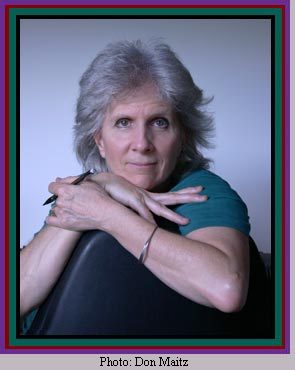 About the Author
About the Author
Janny Wurts is the author of War of Light and Shadow series, and To Ride Hell’s Chasm. Her eighteen published titles include a trilogy in audio, a short story collection, as well as the internationally best selling Empire trilogy, co authored with Raymond E. Feist, with works translated into fifteen languages worldwide. Her latest title in the Wars of Light and Shadow series, Initiate’s Trial, culminates more than thirty years of carefully evolved ideas. The cover images on the books, both in the US and abroad, are her own paintings, depicting her vision of characters and setting.
Through her combined talents as a writer/illustrator, Janny has immersed herself in a lifelong ambition: to create a seamless interface between words and pictures that will lead reader and viewer into the imagination. Her lavish use of language invites the mind into a crafted realm of experience, with characters and events woven into a complex tapestry, and drawn with an intensity to inspire active fuel for thought. Her research includes a range of direct experience, lending her fantasy a gritty realism, and her scenes involving magic crafted with intricate continuity. A self-taught painter, she draws directly from the imagination, creating scenes in a representational style that blurs the edges between dream and reality. She makes few preliminary sketches, but envisions her characters and the scenes that contain them, then executes the final directly from the initial pencil drawing.
The seed idea for the Wars of Light and Shadow series occurred, when, in the course of researching tactic and weapons, she viewed a documentary film on the Battle of Culloden Moor. This was the first time she had encountered that historical context of that brutal event, with the embroidery of romance stripped from it. The experience gave rise to an awakening, which became anger, that so often, our education, literature and entertainment slant history in a manner that equates winners and losers with moral right and wrong, and the prevalent attitude, that killing wars can be seen as justifiable solutions when only one side of the picture is presented.
Her series takes the stance that there are two sides to every question, and follows two characters who are half brothers. One a bard trained as a master of magecraft, and the other a born ruler with a charismatic passion for justice, have become cursed to lifelong enmity. As one sibling raises a devoted mass following, the other tries desperately to stave off defeat through solitary discipline and cleverness. The conflict sweeps across an imaginary world, dividing land and people through an intricate play of politics and the inborn prejudices of polarized factions already set at odds. Readers are led on a journey that embraces both viewpoints. The story explores the ironies of morality which often confound our own human condition – that what appears right and just, by one side, becomes reprehensible when seen from the opposite angle. What is apparently good for the many, too often causes devastating suffering to the nonconformist minority. Through the interactions between the characters themselves, the reader is left to their own discretion to interpret the moral impact of events.
Says Janny of her work, “I chose to frame this story against a backdrop of fantasy because I could handle even the most sensitive issues with the gloves off – explore the myriad angles of our troubled times with the least risk of offending anyone’s personal sensibilities. The result, I can hope, is an expanding journey of the spirit that explores the grand depths, and rises to the challenge of mapping the ethereal potential of an evolving planetary consciousness… explore free thought and compassionate understanding.”
Beyond writing, Janny’s award winning paintings have been showcased in exhibitions of imaginative artwork, among them a commemorative exhibition for NASA’s 25th Anniversary; the Art of the Cosmos at Hayden Planet
Learn more about the author on her website.
A Select List of 8 Astonishing Overlooked SFF Titles
by Janny Wurts
Sometimes the boggling happens: a title with huge scope or depth or originality, done with panache and quality writing, gets buried. Maybe because the concepts were ahead of their time, and the readership was not ready; maybe because they had a deep vein of philosophy, courageously expressed; maybe because – who knows?
Each of these books marked me in some way – more than delivered a read of sheer pleasure. These works provoke thought, or own a quality of originality that’s stayed remarkable and fresh, years after I discovered them. For reasons that mystify, these titles are not just “under the radar.” They’ve been so extremely buried, not one has (yet) accumulated a thousand ratings on GoodReads. For no imaginable reason, because each is an awesome voyage of discovery, a treasure in its own right, a list of my favorites fitted to expand your horizons.
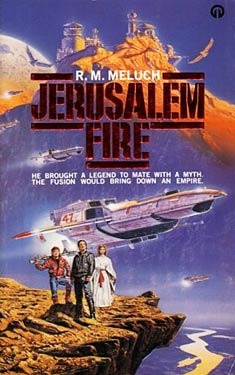
JERUSALEM FIRE by R. M. Meluch
Buy the book
Space opera that becomes a powerful examination of conflict from a one sided view that expands, unfolding with unexpected twists and turns. The prose is beautiful, the characters well drawn, and the topic, serious and deeply examined, and never more timely and current than today. R. M. Meluch throughout her career has consistently done solid work. This book stands out as exceptional. It had great critical review on release, but somehow failed to find its momentum. Don’t let the title mislead. Jerusalem is not today/here and now earth, but altogether SFnal, otherworldly and different.
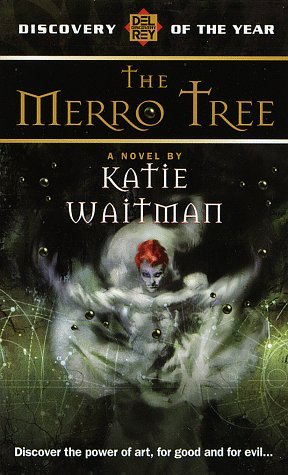
THE MERRO TREE – Katie Waitman
Buy the book
This book is amazing. Poetic prose, gorgeous style, and an exploration of cultural differences intersecting with the profound impact of art as entertainment. This theme is done so exceptionally well, it is hallmark. Read this book, you will never, ever forget the raw tension, the tender examination of relationships between species, and what it means to be human, or other. Critical review for this title also was very high on release. The ideas are never more pertinent. This book might have swept the awards, if the field had today’s sense of focus, scope and vision.
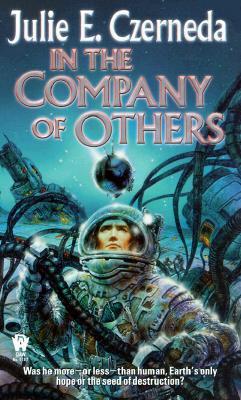
IN THE COMPANY OF OTHERS – Julie E. Czerneda
Buy the book
Why is every reader who loves the philosophy and tight thread of politics in C J Cherryh’s beloved work not reading this? Czerneda captures the wonder, the tension, the crowding, the restriction of space, and the tight quarters tension of a diverse population inhabiting ancient hardware in space. The central theme is so awesome, this book ought to be shaking up a new and visionary direction in the field. This is a standalone novel, and well worth looking up for a smooth read that delivers thought with entertaining verve.

LION’S BLOOD and ZULU HEART – Steven Barnes
Buy Lion’s Blood
Buy Zulu Heart
Ahead of its time? Definitely. Alternate history has really taken off, since these titles were written, and diversity is now a hot topic. How about a book that flips history and race – where the blacks are the Southern landholders and the whites are enslaved? These books explore an alternate history with a sensitivity and daring far ahead of the curve, at the time of release. Uncomfortable, thought provoking, well executed, unpredictable – what’s not to love?
CODE OF CONDUCT – Kristine Smith
Buy the book
SF, this is the first book in the Janni Killian series that carved some incredible new ground – so new, it was utterly overlooked. The stage of cultural diplomacy assumes a whole new level, between human and alien species – and the ‘ambassador’ caught on the line in between is a female combat vet who has been genetically altered (at first without her knowledge) to mix the qualities of both and perhaps avert a war of annihilation. Part thriller, part hard SF, part diplomatic war zone, this book shattered gender roles so thoroughly, and plowed new ground way before the topic became timely. Love these books for their verve, their complexity, for a totally relatable main character injured by war in body and mind, and for a vision that follows no stereotype. Honor Harrington with a Difference, I found the entire series strikingly memorable.

THE WILD ROAD – Gabriel King
Buy the book
This unworldly delight of a story puts feral cats in the protagonist’s seat, gives them astonishing powers of magic, and sets them loose in the human world with a sharp edged perspective, wit, and terrifying, sometimes beautiful insight. Actually a collaboration between the extremely literate M. John Harrison of SF renown, and Jane Johnson aka Jude Fisher, this series of books combines the talents of two very different writers and yields a bewitching urban fantasy beyond the world we know. No cuddly kittens here – these cats are feral to the bone and their way of dealing with the humans who are messing up their reality – and the crossings between what is other – provides magic, grit, and scary realism from a wonderfully alternate perspective.

TEOT’S WAR and BLOOD STORM – Heather Gladney
Buy Teot’s War
Buy Blood Storm
A duology under the title of The Song of Naga Teot that has a deadly serious, and deadly for real, protagonist who is a cultural fish out of water, depicted small in stature and huge in determination. Expect to laugh, expect to be entertained, expect plenty of grit and bloodshed, as the characters wise perspective and wrecking misadventures grab your heart. Also included, a close up relationship between two male characters that is tender, insightful, and peppered with angst and misunderstanding. These are fast moving, wonderful reads that handle tension and action with gorgeous ease, and are character driven to the max. Another book handling themes of diversity decades before such things were noticed.
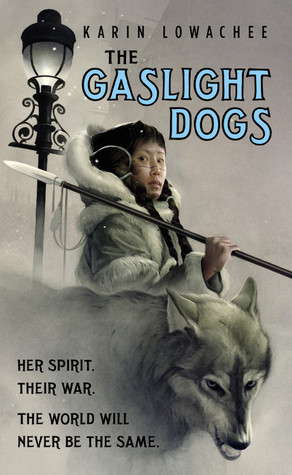
GASLIGHT DOGS – Karin Lowachee
Buy the book
Don’t let the female byline fool you. Karin’s work has edges, stares unflinching into the grit and the horror, and walks the borderline half world between the sane and the insane, all wrapped in sublime prose and dimensional characters. An ambitious amalgamaton of themes, smelted into a visceral story line with graphic clarity: cross cultural conflict, psychedelic magic straight out of mythos, shapeshifters, Inuit, and the razor‑eged relationship between a son and a military father. I have always wondered if the soft edged cover art directed this title to the wrong market. Karin’s work has often dared the edges, handled taboo subjects with brazen directness, and not yet with the recognition she deserves.





